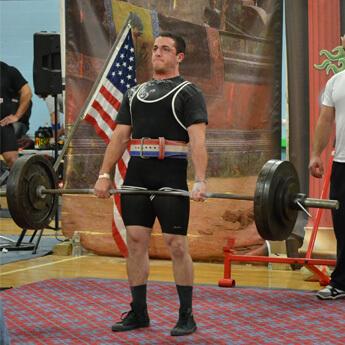78 Science Backed Benefits of Weightlifting for Seniors
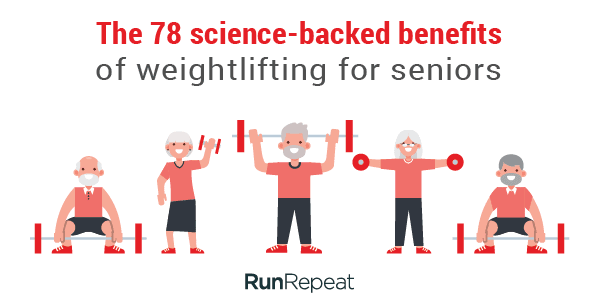
The aging process is a daunting and inevitable one.
Which is why effort and action must be taken to improve the overall health, longevity, and quality of life.
Despite this, 80% of adults are not engaging in enough physical activity to reach prescribed guidelines and full health benefits of exercise. In general, but especially for seniors, inactivity and a sedentary lifestyle are extremely dangerous.
What are the dangers exactly? Increased risk of serious adverse health conditions such as blood pressure, heart disease, stroke, obesity, cholesterol issues, metabolic syndrome, diabetes, cancer, depression, and death from any cause. In 2008 there were 5.3 million deaths worldwide caused by a lack of physical activity out of the 57 million deaths worldwide.122
Many people know weightlifting is hugely beneficial but think light walking or recreational activity is “good enough” for seniors. There is this misconception that older aged individuals should stay away from any strenuous activity that can build strength like weightlifting. Continuing on completely unaware of the benefits of strength training.
Unfortunately, this couldn’t be further from the truth.
Because of this, I spent hours upon hours researching and reading over 200 scientifically backed, peer-reviewed studies, 126 of which were used specifically for this article. All in order to provide you with 78 benefits of strength training for older adults and elderly.
Benefits of Strength Training for Seniors: Key Conclusions

Physical Fitness for Healthy Aging: Is resistance training with weights safe?
It is a good question. At any age there is a level of “danger” that comes with weightlifting in all of its forms. But are there greater risks or dangers for those who are in the older populations?
There have been hundreds, if not thousands, of studies with volunteers from ages 55-90 weight training. Training with weights, whether that be heavy or light, has been shown to be a safe, enjoyable, and beneficial activity for older adults and the elderly.2
But, as with all ages, there is always a risk of injury. To keep it safe, studies suggest using safe equipment, careful warming up and cooling down, and a focus on using the correct range of motion is important.79 You should be sharing your new or current physical endeavors with your doctor and get the two thumbs up from them as well.
What about the type of training? The safest type of training focuses on progressive increases in intensity, much like the Stronglifts 5x5 Workout. The focus being on power development that increases the speed of force production.79
Through this training, the level of cardiovascular and musculoskeletal fitness improves. These improvements are a key factor in injury prevention among older adults and the elderly.79 This is especially true for seniors who hope to remain active in their favorite actities and sports. For example, strength training for golf is known to significantly aid in injury prevention.
So not only is weightlifting safe, there are also ways to increase the level of safety of the activity. All while playing a major role in reducing the overall chance of injury.
10 benefits of weightlifting for age-related muscle loss/sarcopenia for seniors
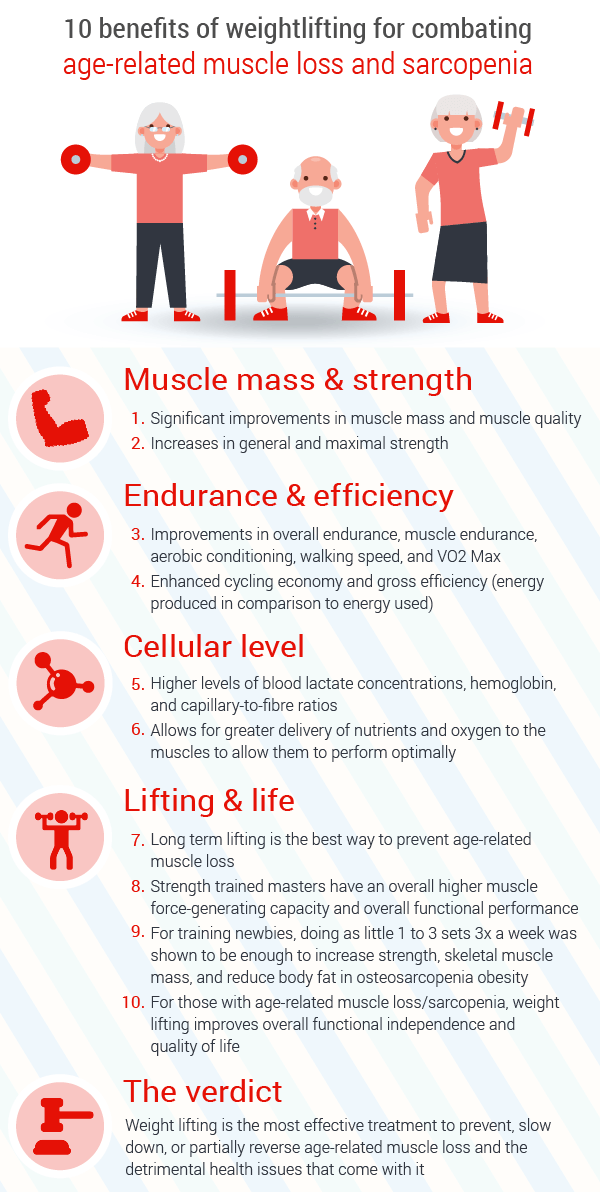
As age increases, muscle mass and strength decreases. From age 50 muscle mass begins to decrease by 1-2% annually. In your 50s, muscle strength starts to fall by 1.5% and from age 60 and older it begins to decrease by 3% annually. 120
It is estimated that 5-13% of elderly people in the age range of 60-70 years old and 11-50% for those aged 80 or above suffer from sarcopenia (age-related muscle loss).120 This issue can lead to an increase in frailty and a significant increase in the risk of falls.
The continued loss of lean muscle mass with age adds to the development of age-related metabolic dysfunction.
Strength Training for Muscle Mass & Strength
#1 Although it may be obvious, picking things up and putting them down improves muscle mass and muscle quality.4,6,7,8,13,16,39,42,94
#2 While your building that muscle you are also experiencing Increases in general strength, maximal strength, and muscle power.4,6,8,13,16,39,40,42,57,73,94
Resistance Training Benefits For Endurance & Efficiency
#3 Not only will you be building muscle, your overall endurance will have a boost as well. Weightlifting improves the endurance of the muscles themselves, aerobic conditioning, and walking speed. Participants also demonstrated an increase in VO2 max. The max amount of oxygen you can use during exercise. 4,13,17,40,41
#4 These improvements in endurance were also seen by increasing cycling economy and the overall gross efficiency, the amount of energy produced in relation to the total energy used. 50
Think about gross efficiency as trying to start a fire. If you did it by rubbing sticks together it will take a great deal of energy to produce the fire. In comparison, just flicking a lighter and holding it on for a little requires less energy.
The greater the gross efficiency the more energy produced in comparison to the energy used.
Weight Training Benefits On The Cellular Level
#5 These endurance and efficiency improvements had some support on the molecular level. Support came from higher levels of blood lactate concentrations, hemoglobin, and capillary-to-fibre ratios. 13,50
#6 The increases in blood lactate and hemoglobin both play roles in increasing performance capacity. While the increased capillary-to-fibre ratios allow for greater delivery of nutrients and oxygen to the muscles. All together empowering muscles to perform optimally.13,50
How Strength Training Improves Lifting & Life
#7 Long-term lifting is the best way to prevent age-related muscle loss from ever becoming an issue. 4,6,7,39,51
#8 One study found that strength-trained masters athletes (older adults with long-term strength training) have an overall higher muscle force-generating capacity and level of overall functional performance. Physically active adults with a consistent level of recreational activity were significantly outperformed by “The Masters”. 51
So what if you weren’t ahead of the curve and have limited to no experience in weightlifting? Don’t stress, you don’t need to hit the gym five times a week for hours at a time.
In fact, one study took the guesswork out for you. They even took it a step up by studying this in osteosarcopenia obesity. This is a new geriatric syndrome that is a combination of osteoporosis, sarcopenia, and increased fat mass.
#9 What they found was that by doing 1 set of exercises three times a week were enough to provide increases in strength, skeletal muscle mass, and decreased body fat over 12 weeks. Increasing that to 3 sets of exercises three times a week resulted in a dramatic boost in results. 39
#10 All-in-all making weightlifting a valuable way to improve the overall quality of life and functional independence of those who are suffering from severe age-related muscle loss or sarcopenia. 4,6,7,16,17,39,51
The Verdict
Weightlifting is the most effective treatment to prevent, slow down, or partially reverse age-related muscle loss/sarcopenia. Don't forget about fending off the detrimental health issues that come with it as well.
8 Benefits of weightlifting for fighting obesity and increasing metabolism in seniors
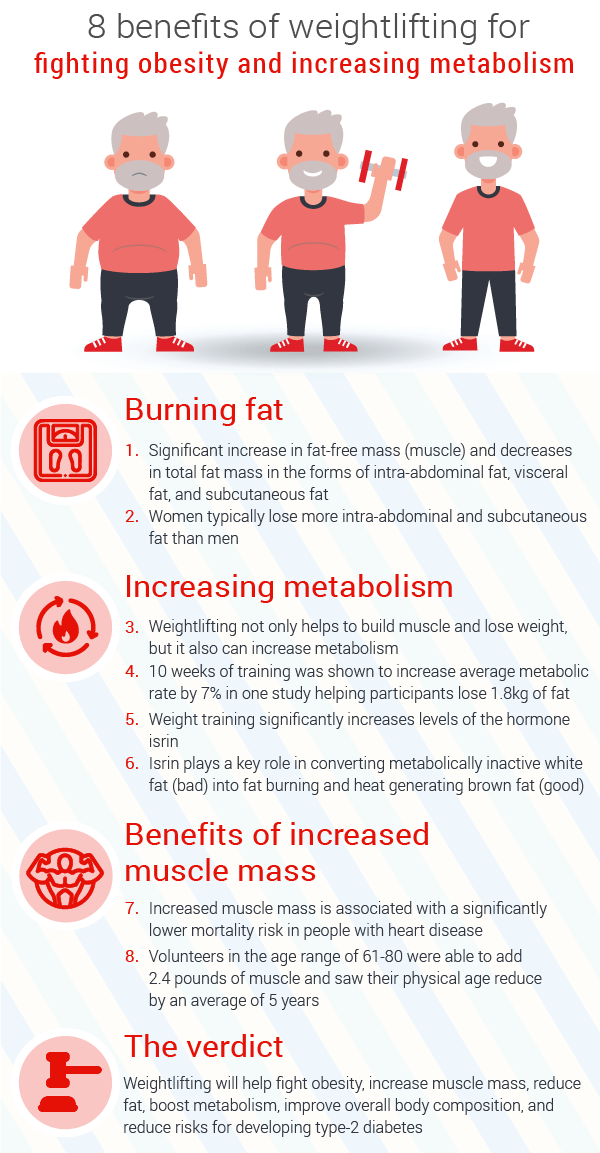
As we age, the levels of important hormones begin to change. Your muscle mass decreases. Along with other critical factors that lead to the inevitable decrease in metabolism. This, in turn with poor health behaviors and a sedentary lifestyle, leads to the increase of fat mass and damaging of your metabolic health. With this come greater risks for functional capacity, metabolic syndrome, diabetes, hypertension, cardiovascular disease, pulmonary abnormalities, cancer, urinary incontinence, cataracts, and more.121
Burning fat no matter your age
#1 Not only will hitting the weights provide gains in the muscle department, it is also an extremely effective strategy for burning fat. Studies demonstrated significant decreases in total fat mass, intra-abdominal fat, and visceral fat. 4,8,13
#2 Although both men and women saw increases in fat-free mass and fat loss, women tend to lose more intra-abdominal and subcutaneous fat. 18
Increasing metabolism to speed up weight loss
#3 Another avenue that weightlifting enhances weight loss is through increasing metabolism. 10,59
#4 One study demonstrated an increase in metabolic rate by 7% and a decrease in fat weight of 1.8kg over 10 weeks of training.10 So not only will you be losing weight and gaining muscle, it will also increase the level of calories your body is burning on its own while active and resting.
#5 Another way it will help burn fat and boost metabolism is by how weight training significantly increases levels of the hormone isrin.12
#6 Isirin is a hormone that plays a role in converting “white fat” into “brown fat”. White fat is used as an energy reserve in the body, insulation, and as a cushion for our organs. But excess white fat is that fun little tummy pouch we have all dreadingly poked at in the mirror. Whereas brown fat contains a large number of mitochondria and blood vessels which plays a role in burning fat and generating heat. By increasing levels of isrin, you are increasing levels of brown fat and increasing overall fat burning potential.
Benefits of increased muscle mass
There is more to this “building muscle” thing than just being in shape and stronger.
#7 Having higher muscle mass is actually associated with a lower mortality risk in people with heart disease. Lower mortality risk is a benefit everyone loves, which we will dive into greater detail later on in this article.36
#8 Volunteers in the age range of 61-80 were able to add 2.4 pounds of muscle and saw their physical age reduce by an average of 5 years. Allowing them to literally feel younger and be healthier.87
The verdict
Weightlifting will help fight obesity, increase muscle mass, reduce fat, boost metabolism, improve overall body composition, and even reduce risks for developing type-2 diabetes.
11 Benefits of weightlifting for reducing risk factors for falls and improving functional independence for seniors
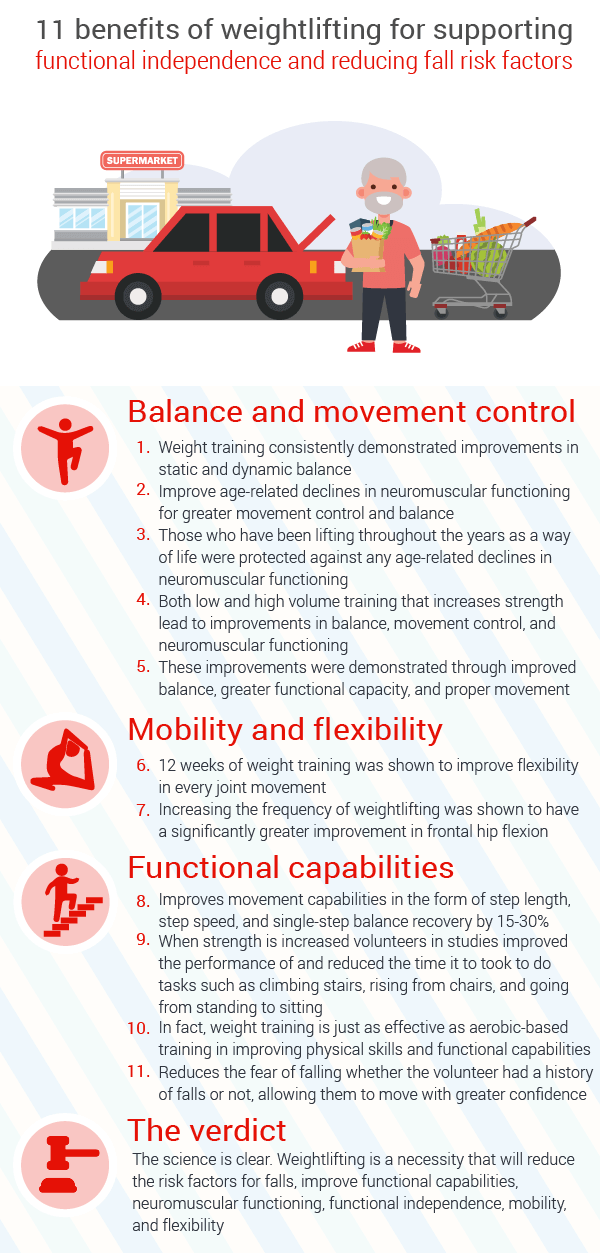
Being able to be functionally independent is a major quality of life factor. The more functional independence you have the less likely you are to experience a fall. Approximately 9,500 deaths in older American adults are connected to a fall each year. On top of this, the vast majority of minor or serious injuries are connected to falls. Those that experience fall will do so again within six months.123
So it is clear, any way to reduce these risk factors and improve functional independence is critical.
Balance and movement control
#1 Starting with the basics, when standing or moving, you need to be able to have solid balance. Training with weights demonstrated consistent improvement in static and dynamic balance. 14,15,41,52,76,81
There is another aspect of biological functioning that also degrades with time and lack of activity. That is your neuromuscular functioning. This is your body’s ability to control movement, proper movement, knowing where your body and all limbs are at all times, understand the amount of effort being put into moving, and balance.
#2 Working with weights improves the age-related declines in neuromuscular functioning. 7,9,42,77,84
#3 Those who have been lifting throughout the years as a way of life have protection against any age-related declines in neuromuscular functioning.9,77
Maybe you are concerned about how much time, energy, and intensity will it require to get these benefits? Do you have to be moving hundreds of lbs on your back, day in and day out, for hours at a time?
#4 This is the best part. Three separate studies were able to show that both low and high-volume weight lifting geared towards improving strength slowly but surely will improve neuromuscular functioning. Not to mention all of the functional benefit that comes with it! 7,42,84
#5 These improvements were demonstrated through improved balance, greater functional capacity, and proper movement. 7
Mobility and flexibility
#6 Another important factor to consider is flexibility. Having proper flexibility at the joints ensures greater functional capabilities. This and safety while doing various movements when up and about. 12-weeks of training was able to improve flexibility in essentially every joint movement. 78
#7 Increasing the frequency of weightlifting provides greater improvement in frontal hip flexion. 78
Functional capabilities
This is all sounds great but how is this going to actually benefit you in the day-to-day activities of your life?
#8 First off, you can move with greater ease and grace. For example, weightlifting was able to improve step length, step speed, and improve single-step balance recovery by 15-30%. 48,52,81
#9 As your strength increases the benefits begin to appear in general functionable capabilities. One study demonstrated that it led performance and time to complete various tasks improves. Specific tasks studied were climbing stairs, rising from chairs, and going from standing to sitting. 66
#10 Weight training is as effective as aerobic-based training in improving physical skills and functional capabilities. 86
#11 Whether you have not had a serious fall yet or you already have a history of falls, there still seems to be a lingering fear of falls. This fear can hold elderly and older adults with limited functional capabilities back from doing the simplest activities or tasks. Thankfully, weightlifting has been shown to reduce the fear of falling whether the volunteer had a history of falls or not. 48,76
The verdict
The science is clear. Weightlifting will help reduce tons of risk factors for falls, improve functional independence, functional capacity, and quality of life.4,7,15,16,52,66,76,86 Making weightlifting a necessity in the growing older adult and elderly populations.
7 Benefits of weightlifting for quality of life for seniors
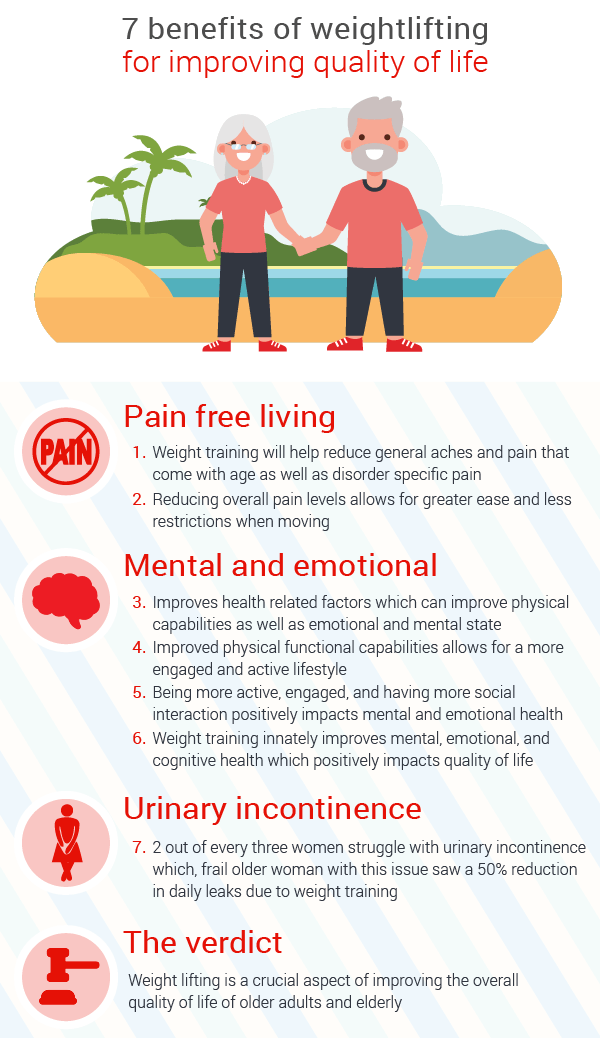
Growing old can be a difficult and scary process. Improving the experience of aging, the health of the older populations, and the quality of life is a valuable endeavor. When these objectives are achieved, it can empower older adults and elderly to live a fuller, more engaged, and active life.
Pain free living
#1 Thankfully, training helps improve the overall quality of life. One way is by reducing the level of general aches and pains as well as disorder-specific pain.3,4,7
#2 That is exactly the point. Reducing pain levels allows for greater ease of movement, fewer restrictions when moving, and in general, feeling better with less negative stimuli coming from your body. 3,4,7
Mental and emotional
#3 On top of being able to move around with less pain, improving strength and muscle through weight lifting improves health-related factors. Which can improve physical capabilities as well as the emotional and mental state. 55
#4 Now with these improved physical functional capabilities you are able to lead a more engaged and active lifestyle.
#5 Being more active, engaged, and having more social interaction is the golden ticket that improves mental and emotional health on various levels.
#6 Weight training also innately improves mental, emotional, and cognitive health through biological mechanisms that enhance the quality of life.
Urinary incontinence
#7 Other areas of quality are less obvious, for example, urinary incontinence. 25 million adults in America suffer with urinary incontinence and 75-80% of those are women.124 23% of women over the age of 60 struggle with incontinence. Frail older women who struggle with this issue who underwent weight training saw a 50% reduction in daily leaks. 54
Verdict
More engaged and active lifestyle. Less pain. Improved cognitive, mental, and emotional health. Weightlifting is a crucial aspect of improving the quality of life of older adults and elderly.
5 Benefits of weightlifting for improving osteoarthritis and bone health for seniors
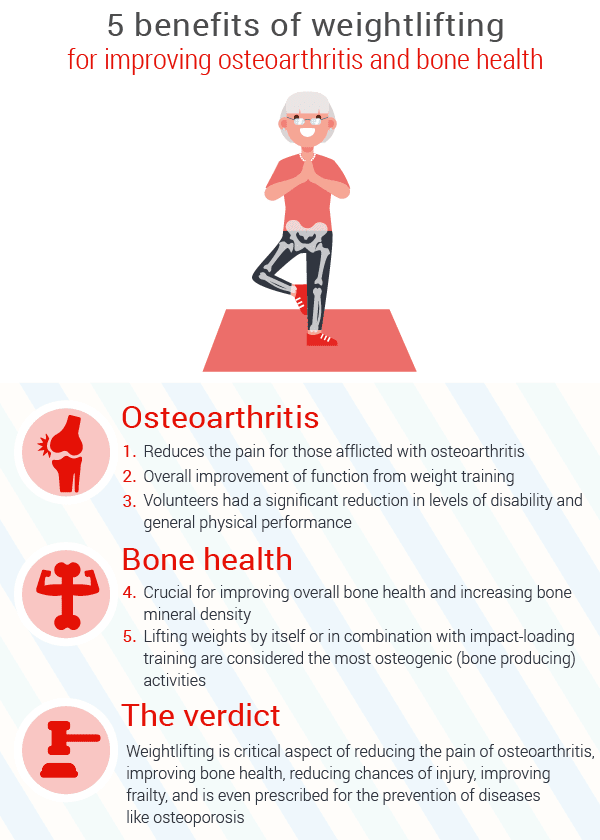
Over 30 million adults in the US struggle with osteoarthritis.125 Factors like obesity, previous injuries, muscle weakness, bone density, and joint health play a role in the development of osteoarthritis and osteoporosis. With this diagnosis comes a great deal of pain from moving, stiffness, loss of flexibility in the joints, and overall impeding a pain-free life.
Osteoarthritis
#1 Weightlifting has been shown across several studies to reduce the pain for those afflicted with osteoarthritis.4,23,37,38
#2 On top of that, they were able to demonstrate an improvement in function for those with osteoarthritis. 4,23,37,38
#3 This included a significant reduction in levels of the measure of disability and general physical performance. 37,38
Bone health
Every year that adults do not perform weight training or general strength and muscle building activities, they may experience a reduction in bone mineral density. This reduction can range anywhere from 1-3%.10 This alarming statistic shows how the combination of aging, a sedentary lifestyle, and any other potential bad health behaviors can accumulate into a great deal of issues down the road.
#4 To counteract this there is a major need for weightlifting. This is because it was demonstrated to help improve bone mineral density and overall bone health.11,102
#5 In fact, weight training alone or in combination with impact-loading types of training are the most osteogenic, bone producing, activities one can do. 12,102
Verdict
Weightlifting is a critical aspect of reducing the pain of osteoarthritis, improving bone health, reducing chances of injury, improving frailty, and is even prescribed for the prevention of diseases like osteoporosis.
5 Benefits of weightlifting for cardiovascular health for seniors
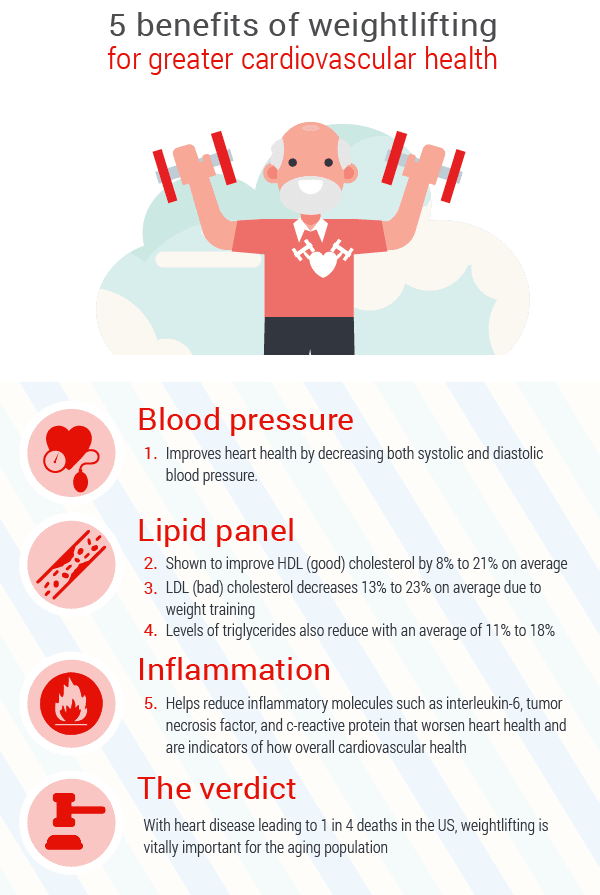
According to the CDC, 1 in every 4 deaths, or 610,000 people die of some form of heart disease in the US every year. It is the leading cause of death for both men and women with around 735,000 individuals in the US experiencing a heart attack each year.
With aging, there tends to be less and less physical activity. On top of this, there is a deterioration of the cells that maintain the natural beating pace of the heart, and increased rigidity of the heart.126 All leading to reduced or slowed flow of blood throughout the body. With other factors playing a role in this issue, it becomes a major focus and cause of concern for the aging population.
Blood Pressure
#1 Weightlifting is known to improve many factors of cardiovascular health, with one being blood pressure. Showing the ability to decrease both the systolic and diastolic blood pressure. 4
Lipid Panel
It is also known to significantly improve your lipid panel which is detailed in systematic reviews and many specific studies.
#2 High-Density Lipoprotein or HDL (good) cholesterol can be difficult to improve. With that said, weightlifting has been shown to improve HDL (good) cholesterol by 8% to 21% on average. 13,22,61,65,71
#3 Low-Density Lipoprotein or LDL (bad) cholesterol was shown to decrease 13% to 23% on average due to weight training.13,22,60,61,65,71
#4 Levels of triglycerides also reduced an average of 11% to 18%.13,22,65
Inflammation
#5 On a more detailed point, researchers also noticed that weight training reduced levels of several inflammatory molecules. Specifically, interleukin-6, tumor necrosis factor alpha, and c-reactive protein.
These molecules in the body are all produced in response to inflammation. They are critical markers that are measured to assess the level of disease and predict future potential cardiovascular events. Some, like interleukin-6 and tumor necrosis factor alpha, can also cause further damage when present at consistently higher levels. 61,65,71
Verdict
With heart disease leading to 1 in 4 deaths in the US, weightlifting is vitally important for the aging population to build not just muscle but a healthier heart and cardiovascular system.
6 Benefits of weightlifting for cognitive functioning in seniors
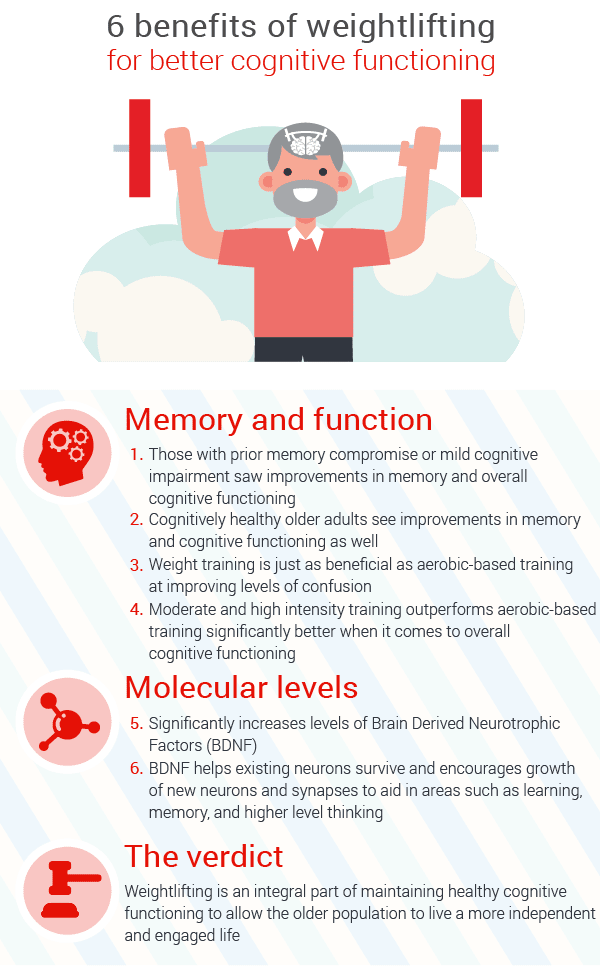
Unfortunately, as you begin to age, your cognitive function can start to decline. You may have experienced this as you aged or have seen loved ones go through this process. Although there is no cure-all for this, anything that can be done to improve it is of great value for the overall quality of life.
Brain Health: Boosting Your Memory and Cognitive Functioning
#1 Those with prior memory compromise or mild cognitive impairment saw improvements in memory and overall cognitive functioning.24,41
#2 What about those who didn’t have prior issues? Older adults who are cognitively healthy also saw an improvement in memory from weight training.26
#3 In case you were wondering, weight training is just as beneficial as aerobic-based training in improving levels of confusion. 86
#4 But when it comes to improving cognitive functioning as a whole, moderate and high-intensity resistance training delivers and does so significantly better than aerobic-based training.25,27
Molecular levels
#5 You see, training promotes an increase of a very important molecule in the brain. This molecule is known as brain-derived neurotrophic factor, or BDNF for short.85
#6 BDNF helps existing neurons survive to help prevent the deterioration of the brain. It also encourages the growth of new neurons and synapses. Therefore, it plays a vital role in various areas of cognitive health such as in learning, memory, and higher level thinking.
Verdict
Weightlifting is an integral part of maintaining healthy cognitive functioning to empower the older population to live a more independent and engaged life.
6 Benefits of weightlifting for mental health in seniors

As decreases in functioning, energy, independence, and ability to do some of the things us youngins’ take for granted begin to occur with age. It can start to take a toll on mental health. Everything from depression, anxiety, reduced self-esteem, and more start to come into play.
Depression
#1 This is where training with weights provides some hope yet again. Weight lifting can lead to significant reductions in depressive symptoms in healthy older adults and the elderly. This was also the case in specific issues such as wheelchair-bound older adults with dementia. 2,43,108,114,116
So how much can weightlifting improve depressive symptoms?
#2 Well, one study used the Hamilton Rating Scale of Depression to measure. They found that when doing high-intensity training 61% of the volunteers and 29% of the low-intensity training volunteers had over a 50% reduction in depressive symptoms. 108
Anxiety
#3 Improving strength through weightlifting is able to improve levels of anxiety and levels of tension. 31,43
Psychological well being
#4 Doing daily light training and training in general was able to improve volunteers’ self-perception of physical well being, functional competency, physical condition, body satisfaction, and self-esteem. So clearly, even just keeping it light and simple can be enough to make some great progress in this department.29,30,113
#5 Weightlifting is also just as effective at improving mood, tension, and levels of fatigue as aerobic-based training. 86
Lastly, one study compared the impact of the amount of sedentary time and level of intensity of the training mental health composite scores.
#6 They found, regardless of what level of intensity the training, that reducing the amount of sedentary time markedly improved the volunteers’ mental health scores. Additionally, the higher intensity also seemed to outperform the low-intensity training groups. 112
Verdict
Having at least daily light training up to consistent high-intensity training are valuable ways to improve the overall mental health of the aging population.
2 Benefits of weightlifting for reducing mortality risk in seniors

All the research above suggests weightlifting is going to help you live a much more functional, independent, and more engaged life through the aging process. In the previous sections, we discussed some ways it will help in the health department with some more to come as well.
These next two come from massive research undertakings in the form of two studies and are probably the most powerful benefits of all.
#1 One European study enlisted 334,161 individuals and followed up with them over 12.4 years. Among the vast amount of data they discovered, they found that those doing as little as 20 minutes of light exercise daily could reduce a person’s risk of early death by as much as 30%.35
#2 The National Health Interview Survey data from 1997-2001 was linked to the National Death Index. The survey responses, demographics, past medical history, and other health behaviors were all collected and analyzed. What they found was that adults 65 and older who reported doing the prescribed amount of strength training (twice a week) had a 46% lower odds of all-cause mortality than those who did not. This percentage remained even after adjusting data for all past medical history and other health behaviors.67
The vast amount of data that these studies drew their conclusions begs the question, can anyone really afford to not be exercising in the form of weight training?
11 Benefits of weightlifting for glycemic control and type 2 diabetes in seniors

Glucose levels
#1 Weightlifting reduces resting blood glucose levels.19,61,65,91,92,93,99,100
#2 Weight training is the better choice for improving glycemic control than aerobic exercise. This is true in healthy adults and adults with type-2 diabetes.19,61,65
Insulin resistance & sensitivity
#3 Insulin resistance is a common factor in the development of pre-diabetes and then diabetes. This means that the cells are unable to use insulin efficiently and therefore do a poor job of absorbing glucose from the blood. Simply put, weightlifting helps reduce entire body insulin resistance. 92
4 It also has been shown to improve insulin sensitivity for up to 24 hours and the amount of glucose uptake by muscle cells for one week. Meaning a single bout of training can help use insulin more efficiently and utilize more glucose for energy in muscles. Rather than going through the unfortunate and complex process of being converted into fatty acids stored in fat tissue.99,107
Molecular level
#5 Participants in studies demonstrated reduced levels of HbA1c, a fancy term for the number of red blood cells that have been bonded by a molecule of glucose.100
#6 Training was also shown to increase hSGLT3 mRNA transcript levels by a factor of 10. This molecule is believed to play a crucial role in sensing glucose levels. This then would lead to signaling the body for a more appropriate response and effective transporting of glucose. This increase in hSGLT3 was correlated with reduced glucose toxicity and improvements in insulin resistance.107
#7 A molecule known as glucose transporter type-4 (GLUT4) increased in density in response to weight training.10 What does that mean?
When you eat and glucose(sugar) levels in our blood increase and insulin is released in response. When insulin attaches to receptors on the plasma membrane (exterior side of the cell), the cell takes GLUT4 “out of storage” and moves it to the plasma membrane. Once GLUT4 is there it will begin transporting and absorbing glucose into the cell.
All this means that training increases GLUT4 density (amount on the outside of the cell) leading to higher levels of glucose absorption into muscle cells and adipose tissue.
#8 Another study found that the training was able to reduce the level of serum blood glucose in type 2 diabetes mellitus at a higher level than in non-diabetics. This improvement was correlated with higher levels of miR-146a circulating in the blood.91 This molecule is typically downregulated in diabetes and although not yet fully understood, seems to play a role in regulating inflammatory molecules as well as a mediator in other important biological processes related to diabetes.
#9 Inflammation is a critical factor to consider in the diseaste state of diabetes. Thankfully, putting work in at the gym helps reduce systemic inflammation significantly. Specifically, they found that it reduced interleukin-6, Tumor Necrosis Factor-alpha (TNF-a), and C reactive protein (CRP).61,92,93,97,106
Molecules such as TNF-a and interleukin-6 play a role in increasing insulin resistance, oxidative stress, and potentially further inflammation which only worsens the state of diabetes. Whereas higher levels of CRP have been shown to be correlated with poorer glycemic control and increased glycosylated hemoglobins.
#10 The hormone adiponectin increases in levels in response to weight training. Produced and secreted by adipose tissue, the role of adiponectin is to help in regulating glucose levels and breaking down fatty acids.92,93
#11 I know these molecule names are getting confusing...but they are important which is why I have to tell you that training also increases interleukin-1 beta and TGF-Beta1 in older adults with type 2 diabetes.106
Interleukin-1 beta plays an inflammatory role where it can lead to the loss of beta-cell mass and beta-cell death (beta-cells are what produced insulin) in the pancreas as well a potential amplifier of cardiovascular events.
As for TGF-Beta1, it also is out for the blood of beta-cells by inhibiting the growth of new beta-cells and inducing beta-cell death. Reducing interleukin-1 and TGF-Beta1 can help improve glycemic control, proper beta-cell functioning, and growth of new, functioning beta-cells.
Verdict
Weightlifting is a powerful tool for helping improve the health status in type-2 diabetes and prevent developing diabetes to the point that studies have shown training being able to reduce the required dosage of prescribed medications.89
3 Benefits of weightlifting for improving sleep in seniors
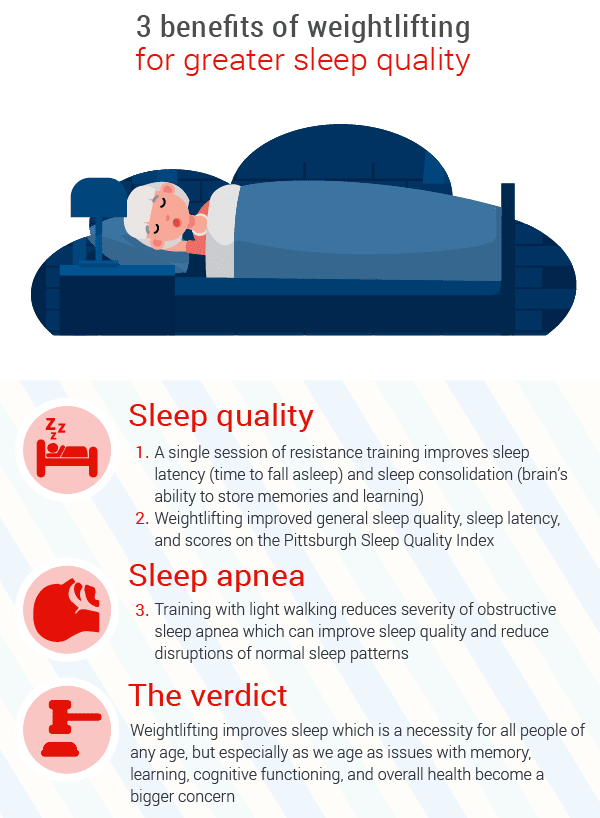
Despite what is common now in our society and culture, “burning the midnight oil” should not be some form of badge of honor. Lack of sleep is a serious issue and health concern. Proper sleep is crucial for improving mental, physical, and emotional health no matter what age you are.
Sleep quality
#1 A single session of resistance training was able to improve sleep latency, the amount of time it takes to fall asleep, as well as sleep consolidation. The last one there, sleep consolidation, is important for proper functioning of the brain’s role in memory and learning.4
#2 On top of that is was able to improve general sleep quality, sleep latency, and scores on the month-long Pittsburgh Sleep Quality Index.3,117
Sleep apnea
#3 Lastly, combining training with some light walking can reduce the severity of obstructive sleep apnea. Although it doesn’t cure you of sleep apnea, any improvement will allow for greater levels of proper breathing, reduce the amount of disruption of normal sleep patterns, and the other issues that can stem from this disorder.83
The verdict
Weightlifting improves sleep which is a necessity for all people of any age, but especially as we age as issues with memory, learning, cognitive functioning, and overall health become a bigger concern.
3 Benefits for age-related mitochondrial impairment in seniors
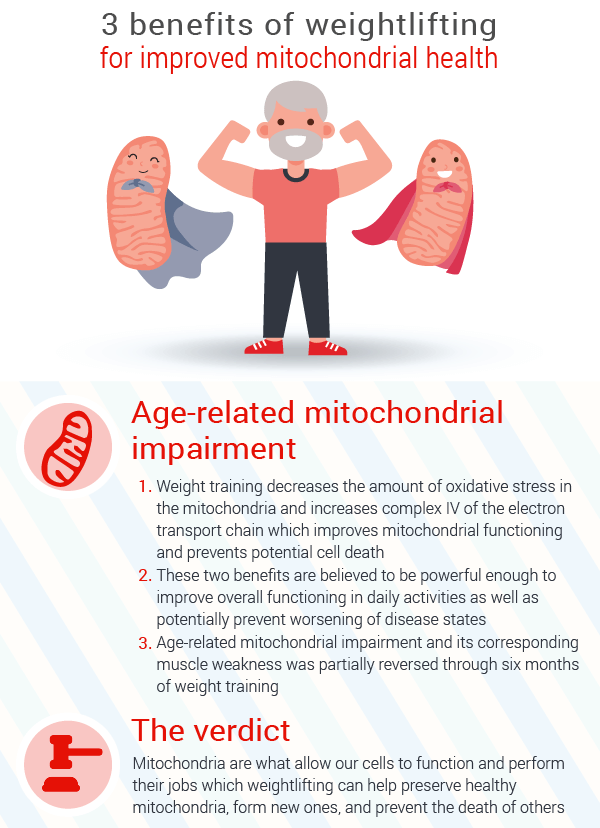
The mitochondria are “the powerhouse” of the cell. Found in every cell in the body, except red blood cells, they are responsible for producing the energy for the cell to do their jobs.
You have probably seen fad products, articles, or programs all around enhancing your mitochondria. But what does that mean and why does it matter?
Here is a little scenario to help show why improving your mitochondrial health is extremely valuable for overall health and longevity.
Think about a typical city as being the human body and the major components being cells. Let’s say the police force, fire department, hospital workers, and emergency medical technicians are all individual cells. Then, we make it so all of the people that fill these roles can only get four hours of sleep a night, eat 1,000 calories, drink two cups of water a day, and no coffee *gasp*. It is clear that this city would be in severe danger, would have an increase in accidents, less success in solving crimes, putting out fires, or saving people’s lives.
This is the exact same thing that happens in the body with mitochondrial impairment. If the cells in your brain aren’t producing enough energy to do their job well, they will be doing their job as well as the sleepy-eyed, emaciated, and most definitely hangry ambulance driving EMT. That’s no good.
This can show its face in the form of reduced performance, impaired health, and a myriad of other aspects of life.
Age-related mitochondrial impairment
Thankfully, weight training can help.
#1 It does this by decreasing the amount of oxidative stress in the mitochondria and increasing complex IV of the electron transport chain (ETC). 32
This oxidative stress at higher levels can cause a cascade of biological mechanisms to occur in the cell that leads to cell death. Whereas complex IV plays a critical role in the functioning of mitochondria. Disorders, where this complex is defected, is severe and typically fatal. By increasing complex IV it allows for greater functioning as well as decreasing the level of oxidative stress.
#2 These two benefits are believed to be powerful enough to improve overall functioning in daily activities as well as potentially prevent worsening of disease states.32
#3 The issue of age-related mitochondrial impairment and the corresponding muscle weakness was shown to be able to be partially reversed through six months of resistance exercise training. Therefore, incorporating weight training into your lifestyle as early as possible will help prevent or postpone this issue for as long as possible. 33
The verdict
Mitochondria are what allow our cells to function and perform their jobs which weightlifting can help preserve healthy mitochondria, form new ones, and prevent the death of others.
The Benefit of weightlifting for seniors with hip fractures
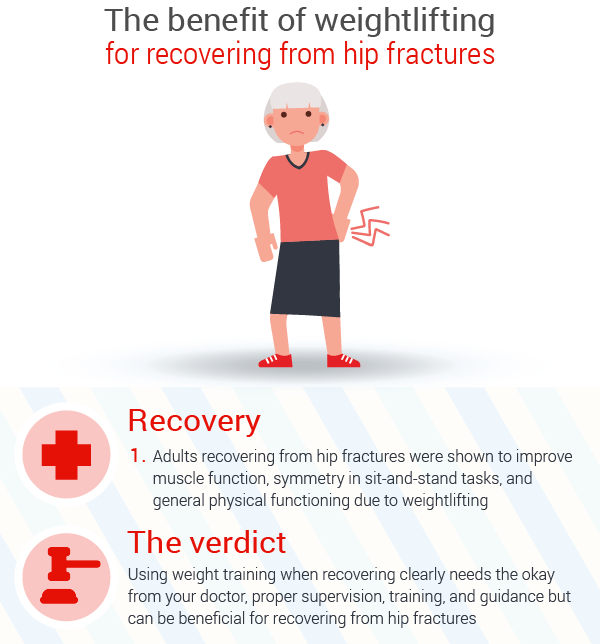
The CDC states that over 300,000 adults 65 years of age or older are hospitalized for hip fractures. Now clearly weightlifting can’t magically reverse this issue but could it help?
Recovery
#1 Adults recovering from hip fractures were shown to improve muscle function, symmetry in sit-and-stand tasks, and general physical functioning due to weightlifting.46
The verdict
Using weight training when recovering clearly needs the okay from your doctor, proper supervision, training, and guidance but can be beneficial for recovering from hip fractures.
It is time to make a change for the better
Start by talking with your doctor.
Reach out to find a certified personal trainer in your area. Or at least take the time and effort to learn how to best workout on your own.
Set a plan in place and take action!
Starting is as simple as doing body weight exercises right now. Through slow, consistent progression, you can graduate to using weights and increasing those weights over time.
The right training shoes can make all the difference
When it comes to lifting weights, your footwear can make a tremendous difference in your overall level of safety, as well as performance.
Which is why it is best to pick up a great pair of training shoes. With weightlifting being the main focus, you will want to grab a pair of weightlifting shoes or CrossFit shoes. Go for a shoe with a flat sole as it will provide a stronger, sturdier, and safer lifting experience. Slipping into a pair of great low drop training shoes will have you feeling a difference immediately.
If you are unsure what brand or shoe to go with, Nike always delivers with its collection of Nike Metcon training shoes. Whereas the Reebok CrossFit Nano training shoes collection is a great option for a wide range of variability in training, seeing how Reebok is the official shoe partner of CrossFit.
Be sure to keep your cardiovascular health up as well by building the habit of daily walks as well. Not only will it help you to just be more active, but it will also provide you with more energy and speed up your recovery from previous workouts. Proper footwear is important, so make sure to use our detailed reviews to find the best walking shoes for you. It's important for the older populations to invest in walking shoes with arch support for stability and that are slip-resistant to avoid falls. For those with limited mobility and difficulty getting your shoes on, go with a pair of slip-on walking shoes.
For help on finding the best shoes for you for working out, learn more from our science-backed guide to lifting shoes. You can read more great, in-depth articles, guides, or research from all of us at RunRepeat here.
Use of content
- Feel free to utilize any material from this article by including a reference of this article as well.
- Reach out to Nick Rizzo at Nick@runrepeat.com for any requests or questions about content use.
Works Cited
1 Akasaki Y, Ouchi N, Izumiya Y, Bernardo BL, Lebrasseur NK, Walsh K. Glycolytic fast-twitch muscle fiber restoration counters adverse age-related changes in body composition and metabolism. Aging Cell. 2014 Feb;13(1):80-91. doi: 10.1111/acel.12153. Epub 2013 Sep 17. PubMed PMID: 24033924; PubMed Central PMCID: PMC3947044.
2 Nichols JF, Omizo DK, Peterson KK, Nelson KP. Efficacy of heavy-resistance training for active women over sixty: muscular strength, body composition, and program adherence. J Am Geriatr Soc. 1993 Mar;41(3):205-10. PubMed PMID: 8440838.
3 Singh NA, Stavrinos TM, Scarbek Y, Galambos G, Liber C, Fiatarone Singh MA. A randomized controlled trial of high versus low intensity weight training versus general practitioner care for clinical depression in older adults. J Gerontol A Biol Sci Med Sci. 2005 Jun;60(6):768-76. PubMed PMID: 15983181.
4 Hurley BF, Roth SM. Strength training in the elderly: effects on risk factors for age-related diseases. Sports Med. 2000 Oct;30(4):249-68. Review. PubMed PMID: 11048773.
5 Cauza E, Hanusch-Enserer U, Strasser B, Kostner K, Dunky A, Haber P. Strength and endurance training lead to different post exercise glucose profiles in diabetic participants using a continuous subcutaneous glucose monitoring system. Eur J Clin Invest. 2005 Dec;35(12):745-51. PubMed PMID: 16313250.
6 Burton, L. A., & Sumukadas, D. (2010). Optimal management of sarcopenia. Clinical Interventions in Aging, 5, 217–228.
7 Aagaard P, Suetta C, Caserotti P, Magnusson SP, Kjaer M. Role of the nervous system in sarcopenia and muscle atrophy with aging: strength training as a countermeasure. Scand J Med Sci Sports. 2010 Feb;20(1):49-64. doi: 10.1111/j.1600-0838.2009.01084.x. Review. PubMed PMID: 20487503.
8 Devries, M. C., Breen, L., Von Allmen, M., MacDonald, M. J., Moore, D. R., Offord, E. A., … Phillips, S. M. (2015). Low-load resistance training during step-reduction attenuates declines in muscle mass and strength and enhances anabolic sensitivity in older men. Physiological Reports, 3(8), e12493.
9 Unhjem R, Nygård M, van den Hoven LT, Sidhu SK, Hoff J, Wang E. Lifelong strength training mitigates the age-related decline in efferent drive. J Appl Physiol (1985). 2016 Aug 1;121(2):415-23. doi: 10.1152/japplphysiol.00117.2016. Epub 2016 Jun 23. PubMed PMID: 27339181.
10 Westcott WL. Resistance training is medicine: effects of strength training on health. Curr Sports Med Rep. 2012 Jul-Aug;11(4):209-16. doi: 10.1249/JSR.0b013e31825dabb8. PubMed PMID: 22777332.
11 Gómez-Cabello A, Ara I, González-Agüero A, Casajús JA, Vicente-Rodríguez G. Effects of training on bone mass in older adults: a systematic review.Sports Med. 2012 Apr 1;42(4):301-25. doi: 10.2165/11597670-000000000-00000. Review. PubMed PMID: 22376192.
12 Bolam KA, van Uffelen JG, Taaffe DR. The effect of physical exercise on bone density in middle-aged and older men: a systematic review. Osteoporos Int. 2013 Nov;24(11):2749-62. doi: 10.1007/s00198-013-2346-1. Epub 2013 Apr 4. Review. PubMed PMID: 23552825.
13 Hagerman FC, Walsh SJ, Staron RS, Hikida RS, Gilders RM, Murray TF, Toma K, Ragg KE. Effects of high-intensity resistance training on untrained older men. I. Strength, cardiovascular, and metabolic responses. J Gerontol A Biol Sci Med Sci. 2000 Jul;55(7):B336-46. PubMed PMID: 10898247.
14 Barry BK, Carson RG. The consequences of resistance training for movement control in older adults. J Gerontol A Biol Sci Med Sci. 2004 Jul;59(7):730-54. Review. PubMed PMID: 15304540.
15 Holviala JH, Sallinen JM, Kraemer WJ, Alen MJ, Häkkinen KK. Effects of strength training on muscle strength characteristics, functional capabilities, and balance in middle-aged and older women. J Strength Cond Res. 2006 May;20(2):336-44. PubMed PMID: 16686561.
16 Henwood TR, Taaffe DR. Improved physical performance in older adults undertaking a short-term programme of high-velocity resistance training.Gerontology. 2005 Mar-Apr;51(2):108-15. PubMed PMID: 15711077.
17 Schlicht J, Camaione DN, Owen SV. Effect of intense strength training on standing balance, walking speed, and sit-to-stand performance in older adults.J Gerontol A Biol Sci Med Sci. 2001 May;56(5):M281-6. PubMed PMID: 11320107.
18 Hunter GR, Bryan DR, Wetzstein CJ, Zuckerman PA, Bamman MM. Resistance training and intra-abdominal adipose tissue in older men and women. Med Sci Sports Exerc. 2002 Jun;34(6):1023-8. PubMed PMID: 12048332.
19 Bweir S, Al-Jarrah M, Almalty AM, Maayah M, Smirnova IV, Novikova L, Stehno-Bittel L. Resistance exercise training lowers HbA1c more than aerobic training in adults with type 2 diabetes. Diabetol Metab Syndr. 2009 Dec 10;1:27. doi: 10.1186/1758-5996-1-27. PubMed PMID: 20003276; PubMed Central PMCID: PMC2800839.
20 Campbell WW, Crim MC, Young VR, Evans WJ. Increased energy requirements and changes in body composition with resistance training in older adults. Am J Clin Nutr. 1994 Aug;60(2):167-75. PubMed PMID: 8030593.
21 Ibañez J, Izquierdo M, Argüelles I, Forga L, Larrión JL, García-Unciti M, Idoate F, Gorostiaga EM. Twice-weekly progressive resistance training decreases abdominal fat and improves insulin sensitivity in older men with type 2 diabetes. Diabetes Care. 2005 Mar;28(3):662-7. PubMed PMID: 15735205.
22 American College of Sports Medicine., Chodzko-Zajko WJ, Proctor DN, Fiatarone Singh MA, Minson CT, Nigg CR, Salem GJ, Skinner JS. American College of Sports Medicine position stand. Exercise and physical activity for older adults. Med Sci Sports Exerc. 2009 Jul;41(7):1510-30. doi: 10.1249/MSS.0b013e3181a0c95c. PubMed PMID: 19516148.
23 Zhang W, Moskowitz RW, Nuki G, Abramson S, Altman RD, Arden N, Bierma-Zeinstra S, Brandt KD, Croft P, Doherty M, Dougados M, Hochberg M, Hunter DJ, Kwoh K, Lohmander LS, Tugwell P. OARSI recommendations for the management of hip and knee osteoarthritis, part I: critical appraisal of existing treatment guidelines and systematic review of current research evidence.Osteoarthritis Cartilage. 2007 Sep;15(9):981-1000. Epub 2007 Aug 27. Review. PubMed PMID: 17719803.
24 Cassilhas RC, Viana VA, Grassmann V, Santos RT, Santos RF, Tufik S, Mello MT. The impact of resistance exercise on the cognitive function of the elderly.Med Sci Sports Exerc. 2007 Aug;39(8):1401-7. PubMed PMID: 17762374.
25 Alexandre Leopold Busse, Wilson Jacob Filho, Regina Miskian Magaldi, Venceslau Antônio Coelho, Antônio César Melo, Rosana Aparecida Betoni, José Maria Santarém. Effects of resistance training exercise on cognitive performance in elderly individuals with memory impairment: results of a controlled trial. Einstein (Sao Paulo), Volume 6, Number 4, 2008, pp. 402-407(6)
26 Lachman ME, Neupert SD, Bertrand R, Jette AM. The effects of strength training on memory in older adults. J Aging Phys Act. 2006 Jan;14(1):59-73. PubMed PMID: 16648652.
27 Colcombe S, Kramer AF. Fitness effects on the cognitive function of older adults: a meta-analytic study. Psychol Sci. 2003 Mar;14(2):125-30. PubMed PMID: 12661673.
28 Tsutsumi T, Don BM, Zaichkowsky LD, Takenaka K, Oka K, Ohno T. Comparison of high and moderate intensity of strength training on mood and anxiety in older adults. Percept Mot Skills. 1998 Dec;87(3 Pt 1):1003-11. PubMed PMID: 9885072.
29 Courneya KS, Segal RJ, Mackey JR, Gelmon K, Reid RD, Friedenreich CM, Ladha AB, Proulx C, Vallance JK, Lane K, Yasui Y, McKenzie DC. Effects of aerobic and resistance exercise in breast cancer patients receiving adjuvant chemotherapy: a multicenter randomized controlled trial. J Clin Oncol. 2007 Oct 1;25(28):4396-404. Epub 2007 Sep 4. PubMed PMID: 17785708.
30 Sjögren T, Nissinen KJ, Järvenpää SK, Ojanen MT, Vanharanta H, Mälkiä EA. Effects of a physical exercise intervention on subjective physical well-being, psychosocial functioning and general well-being among office workers: a cluster randomized-controlled cross-over design. Scand J Med Sci Sports. 2006 Dec;16(6):381-90. PubMed PMID: 17121639.
31 Tsutsumi T, Don BM, Zaichkowsky LD, Takenaka K, Oka K, Ohno T. Comparison of high and moderate intensity of strength training on mood and anxiety in older adults. Percept Mot Skills. 1998 Dec;87(3 Pt 1):1003-11. PubMed PMID: 9885072.
32 Parise G, Brose AN, Tarnopolsky MA. Resistance exercise training decreases oxidative damage to DNA and increases cytochrome oxidase activity in older adults. Exp Gerontol. 2005 Mar;40(3):173-80. PubMed PMID: 15763394.
33 Melov S, Tarnopolsky MA, Beckman K, Felkey K, Hubbard A. Resistance exercise reverses aging in human skeletal muscle. PLoS One. 2007 May 23;2(5):e465. PubMed PMID: 17520024; PubMed Central PMCID: PMC1866181.
34 Viana VA, Esteves AM, Boscolo RA, Grassmann V, Santana MG, Tufik S, de Mello MT. The effects of a session of resistance training on sleep patterns in the elderly. Eur J Appl Physiol. 2012 Jul;112(7):2403-8. doi: 10.1007/s00421-011-2219-2. Epub 2011 Nov 2. PubMed PMID: 22045416.
35 Ekelund U, Ward HA, Norat T, Luan J, May AM, Weiderpass E, Sharp SJ, Overvad K, Østergaard JN, Tjønneland A, Johnsen NF, Mesrine S, Fournier A, Fagherazzi G, Trichopoulou A, Lagiou P, Trichopoulos D, Li K, Kaaks R, Ferrari P, Licaj I, Jenab M, Bergmann M, Boeing H, Palli D, Sieri S, Panico S, Tumino R, Vineis P, Peeters PH, Monnikhof E, Bueno-de-Mesquita HB, Quirós JR, Agudo A, Sánchez MJ, Huerta JM, Ardanaz E, Arriola L, Hedblad B, Wirfält E, Sund M, Johansson M, Key TJ, Travis RC, Khaw KT, Brage S, Wareham NJ, Riboli E. Physical activity and all-cause mortality across levels of overall and abdominal adiposity in European men and women: the European Prospective Investigation into Cancer and Nutrition Study (EPIC).Am J Clin Nutr. 2015 Mar;101(3):613-21. doi: 10.3945/ajcn.114.100065. Epub 2015 Jan 14. PubMed PMID: 25733647; PubMed Central PMCID: PMC4340064.
36 Srikanthan P, Horwich TB, Tseng CH. Relation of Muscle Mass and Fat Mass to Cardiovascular Disease Mortality. Am J Cardiol. 2016 Apr 15;117(8):1355-60. doi: 10.1016/j.amjcard.2016.01.033. Epub 2016 Feb 2. PubMed PMID: 26949037.
37 Ettinger WH Jr, Burns R, Messier SP, Applegate W, Rejeski WJ, Morgan T, Shumaker S, Berry MJ, O'Toole M, Monu J, Craven T. A randomized trial comparing aerobic exercise and resistance exercise with a health education program in older adults with knee osteoarthritis. The Fitness Arthritis and Seniors Trial (FAST). JAMA. 1997 Jan 1;277(1):25-31. PubMed PMID: 8980206.
38 Baker KR, Nelson ME, Felson DT, Layne JE, Sarno R, Roubenoff R. The efficacy of home based progressive strength training in older adults with knee osteoarthritis: a randomized controlled trial. J Rheumatol. 2001 Jul;28(7):1655-65. PubMed PMID: 11469475.
39 Cunha PM, Ribeiro AS, Tomeleri CM, Schoenfeld BJ, Silva AM, Souza MF, Nascimento MA, Sardinha LB, Cyrino ES. The effects of resistance training volume on osteosarcopenic obesity in older women. J Sports Sci. 2018 Jul;36(14):1564-1571. doi: 10.1080/02640414.2017.1403413. Epub 2017 Nov 10. PubMed PMID: 29125017.
40 Cunha PM, Tomeleri CM, Nascimento MAD, Nunes JP, Antunes M, Nabuco HCG, Quadros Y, Cavalcante EF, Mayhew JL, Sardinha LB, Cyrino ES. Improvement of cellular health indicators and muscle quality in older women with different resistance training volumes. J Sports Sci. 2018 May 23:1-6. doi: 10.1080/02640414.2018.1479103. [Epub ahead of print] PubMed PMID: 29790430.
41 Langoni CDS, Resende TL, Barcellos AB, Cecchele B, Knob MS, Silva TDN, Rosa JND, Diogo TS, Silva Filho IGD, Schwanke CHA. Effect of Exercise on Cognition, Conditioning, Muscle Endurance, and Balance in Older Adults With Mild Cognitive Impairment: A Randomized Controlled Trial. J Geriatr Phys Ther. 2018 May 4. doi: 10.1519/JPT.0000000000000191. [Epub ahead of print] PubMed PMID: 29738405.
42 Tøien T, Unhjem R, Øren TS, Kvellestad ACG, Hoff J, Wang E. Neural Plasticity with Age: Unilateral Maximal Strength Training Augments Efferent Neural Drive to the Contralateral Limb in Older Adults. J Gerontol A Biol Sci Med Sci. 2018 Apr 17;73(5):596-602. doi: 10.1093/gerona/glx218. PubMed PMID: 29126270
43 Hernandez R, Andrade FCD, Piedra LM, Tabb KM, Xu S, Sarkisian C. The impact of exercise on depressive symptoms in older Hispanic/Latino adults: results from the '¡Caminemos!' study. Aging Ment Health. 2018 Apr 2:1-6. doi: 10.1080/13607863.2018.1450833. [Epub ahead of print] PubMed PMID: 29608340.
44 Bates A, Furber S, Tiedemann A, Ginn K, van den Dolder P, Howard K, Bauman A, Chittenden C, Franco L, Kershaw M, Sherrington C. Trial Protocol: Home-based exercise programs to prevent falls and upper limb dysfunction among community-dwelling older people: study protocol for the BEST (Balance Exercise Strength Training) at Home randomised, controlled trial. J Physiother. 2018 Apr;64(2):121. doi: 10.1016/j.jphys.2017.10.001. Epub 2018 Mar 28. PubMed PMID: 29605522.
45 Nagai K, Miyamato T, Okamae A, Tamaki A, Fujioka H, Wada Y, Uchiyama Y, Shinmura K, Domen K. Physical activity combined with resistance training reduces symptoms of frailty in older adults: A randomized controlled trial. Arch Gerontol Geriatr. 2018 May - Jun;76:41-47. doi: 10.1016/j.archger.2018.02.005. Epub 2018 Feb 13. PubMed PMID: 29455058.
46 Briggs RA, Houck JR, LaStayo PC, Fritz JM, Drummond MJ, Marcus RL. High-Intensity Multimodal Resistance Training Improves Muscle Function, Symmetry during a Sit-to-Stand Task, and Physical Function Following Hip Fracture. J Nutr Health Aging. 2018;22(3):431-438. doi: /10.1007/s12603-017-0977-1. PubMed PMID: 29484358.
47 Levin O, Netz Y, Ziv G. The beneficial effects of different types of exercise interventions on motor and cognitive functions in older age: a systematic review. Eur Rev Aging Phys Act. 2017 Dec 21;14:20. doi: 10.1186/s11556-017-0189-z. eCollection 2017. Review. PubMed PMID: 29276545; PubMed Central PMCID: PMC5738846.
48 Wollesen B, Mattes K, Schulz S, Bischoff LL, Seydell L, Bell JW, von Duvillard SP. Effects of Dual-Task Management and Resistance Training on Gait Performance in Older Individuals: A Randomized Controlled Trial. Front Aging Neurosci. 2017 Dec 13;9:415. doi: 10.3389/fnagi.2017.00415. eCollection 2017. PubMed PMID: 29326581; PubMed Central PMCID: PMC5733355.
49 Ribeiro AS, Deminice R, Schoenfeld BJ, Tomeleri CM, Padilha CS, Venturini D, Barbosa DS, Sardinha LB, Cyrino ES. Effect of Resistance Training Systems on Oxidative Stress in Older Women. Int J Sport Nutr Exerc Metab. 2017 Oct;27(5):439-447. doi: 10.1123/ijsnem.2016-0322. Epub 2017 Apr 19. PubMed PMID: 28422533.
50 Fernández-Lezaun E, Schumann M, Mäkinen T, Kyröläinen H, Walker S. Effects of resistance training frequency on cardiorespiratory fitness in older men and women during intervention and follow-up. Exp Gerontol. 2017 Sep;95:44-53. doi: 10.1016/j.exger.2017.05.012. Epub 2017 May 16. PubMed PMID: 28526625.
51 Unhjem R, van den Hoven LT, Nygård M, Hoff J, Wang E. Functional Performance With Age: The Role of Long-Term Strength Training. J Geriatr Phys Ther. 2017 Aug 3. doi: 10.1519/JPT.0000000000000141. [Epub ahead of print] PubMed PMID: 28786909
52 Papa EV, Dong X, Hassan M. Resistance training for activity limitations in older adults with skeletal muscle function deficits: a systematic review. Clin Interv Aging. 2017 Jun 13;12:955-961. doi: 10.2147/CIA.S104674. eCollection 2017. Review. PubMed PMID: 28670114; PubMed Central PMCID: PMC5479297.
53 Chupel MU, Direito F, Furtado GE, Minuzzi LG, Pedrosa FM, Colado JC, Ferreira JP, Filaire E, Teixeira AM. Strength Training Decreases Inflammation and Increases Cognition and Physical Fitness in Older Women with Cognitive Impairment. Front Physiol. 2017 Jun 12;8:377. doi: 10.3389/fphys.2017.00377. eCollection 2017. PubMed PMID: 28659812; PubMed Central PMCID: PMC5467003.
54 Talley KMC, Wyman JF, Bronas U, Olson-Kellogg BJ, McCarthy TC. Defeating Urinary Incontinence with Exercise Training: Results of a Pilot Study in Frail Older Women. J Am Geriatr Soc. 2017 Jun;65(6):1321-1327. doi: 10.1111/jgs.14798. Epub 2017 Mar 1. PubMed PMID: 28248418; PubMed Central PMCID: PMC5478439.
55 Haraldstad K, Rohde G, Stea TH, Lohne-Seiler H, Hetlelid K, Paulsen G, Berntsen S. Changes in health-related quality of life in elderly men after 12 weeks of strength training. Eur Rev Aging Phys Act. 2017 May 30;14:8. doi: 10.1186/s11556-017-0177-3. eCollection 2017. PubMed PMID: 28572857; PubMed Central PMCID: PMC5450110.
56 McKinnon NB, Connelly DM, Rice CL, Hunter SW, Doherty TJ. Neuromuscular contributions to the age-related reduction in muscle power: Mechanisms and potential role of high velocity power training. Ageing Res Rev. 2017 May;35:147-154. doi: 10.1016/j.arr.2016.09.003. Epub 2016 Sep 30. Review. PubMed PMID: 27697547.
57 Santos L, Ribeiro AS, Schoenfeld BJ, Nascimento MA, Tomeleri CM, Souza MF, Pina FL, Cyrino ES. The improvement in walking speed induced by resistance training is associated with increased muscular strength but not skeletal muscle mass in older women. Eur J Sport Sci. 2017 May;17(4):488-494. doi: 10.1080/17461391.2016.1273394. Epub 2017 Jan 9. PubMed PMID: 28068193.
58 de Oliveira PA, Blasczyk JC, Souza Junior G, Lagoa KF, Soares M, de Oliveira RJ, Filho PJBG, Carregaro RL, Martins WR. Effects of Elastic Resistance Exercise on Muscle Strength and Functional Performance in Healthy Adults: A Systematic Review and Meta-Analysis. J Phys Act Health. 2017 Apr;14(4):317-327. doi: 10.1123/jpah.2016-0415. Epub 2016 Dec 29. Review. PubMed PMID: 28032811.
59 Zhao J, Su Z, Qu C, Dong Y. Effects of 12 Weeks Resistance Training on Serum Irisin in Older Male Adults. Front Physiol. 2017 Mar 22;8:171. doi: 10.3389/fphys.2017.00171. eCollection 2017. PubMed PMID: 28382004; PubMed Central PMCID: PMC5360699.
60 James AP, Whiteford J, Ackland TR, Dhaliwal SS, Woodhouse JJ, Prince RL, Meng X, Kerr DA. Effects of a 1-year randomised controlled trial of resistance training on blood lipid profile and chylomicron concentration in older men. Eur J Appl Physiol. 2016 Dec;116(11-12):2113-2123. Epub 2016 Sep 2. PubMed PMID: 27590313.
61 Tomeleri CM, Ribeiro AS, Souza MF, Schiavoni D, Schoenfeld BJ, Venturini D, Barbosa DS, Landucci K, Sardinha LB, Cyrino ES. Resistance training improves inflammatory level, lipid and glycemic profiles in obese older women: A randomized controlled trial. Exp Gerontol. 2016 Nov;84:80-87. doi: 10.1016/j.exger.2016.09.005. Epub 2016 Sep 9. PubMed PMID: 27616162.
62 Balachandran A, Martins MM, De Faveri FG, Alan O, Cetinkaya F, Signorile JF. Functional strength training: Seated machine vs standing cable training to improve physical function in elderly. Exp Gerontol. 2016 Sep;82:131-8. doi: 10.1016/j.exger.2016.06.012. Epub 2016 Jun 25. PubMed PMID: 27354031
63 Correa CS, Cunha G, Marques N, Oliveira-Reischak Ã, Pinto R. Effects of strength training, detraining and retraining in muscle strength, hypertrophy and functional tasks in older female adults. Clin Physiol Funct Imaging. 2016 Jul;36(4):306-10. doi: 10.1111/cpf.12230. Epub 2015 Feb 11. PubMed PMID: 25678146.
64 Schober-Halper B, Hofmann M, Oesen S, Franzke B, Wolf T, Strasser EM, Bachl N, Quittan M, Wagner KH, Wessner B. Elastic band resistance training influences transforming growth factor-ß receptor I mRNA expression in peripheral mononuclear cells of institutionalised older adults: the Vienna Active Ageing Study (VAAS). Immun Ageing. 2016 Jun 30;13:22. doi: 10.1186/s12979-016-0077-9. eCollection 2016. PubMed PMID: 27375767; PubMed Central PMCID: PMC4929754.
65 Ribeiro AS, Schoenfeld BJ, Souza MF, Tomeleri CM, Venturini D, Barbosa DS, Cyrino ES. Traditional and pyramidal resistance training systems improve muscle quality and metabolic biomarkers in older women: A randomized crossover study. Exp Gerontol. 2016 Jun 15;79:8-15. doi: 10.1016/j.exger.2016.03.007. Epub 2016 Mar 10. PubMed PMID: 26972635.
66 Sundstrup E, Jakobsen MD, Andersen LL, Andersen TR, Randers MB, Helge JW, Suetta C, Schmidt JF, Bangsbo J, Krustrup P, Aagaard P. Positive effects of 1-year football and strength training on mechanical muscle function and functional capacity in elderly men. Eur J Appl Physiol. 2016 Jun;116(6):1127-38. doi: 10.1007/s00421-016-3368-0. Epub 2016 Apr 11. PubMed PMID: 27068158.
67 Kraschnewski JL, Sciamanna CN, Poger JM, Rovniak LS, Lehman EB, Cooper AB, Ballentine NH, Ciccolo JT. Is strength training associated with mortality benefits? A 15year cohort study of US older adults. Prev Med. 2016 Jun;87:121-127. doi: 10.1016/j.ypmed.2016.02.038. Epub 2016 Feb 24. PubMed PMID: 26921660.
68 Lopes PB, Pereira G, Lodovico A, Bento PC, Rodacki AL. Strength and Power Training Effects on Lower Limb Force, Functional Capacity, and Static and Dynamic Balance in Older Female Adults. Rejuvenation Res. 2016 Mar 3. [Epub ahead of print] PubMed PMID: 26707497.
69 Reynolds GO, Otto MW, Ellis TD, Cronin-Golomb A. The Therapeutic Potential of Exercise to Improve Mood, Cognition, and Sleep in Parkinson's Disease.Mov Disord. 2016 Jan;31(1):23-38. doi: 10.1002/mds.26484. Epub 2015 Dec 30. Review. PubMed PMID: 26715466; PubMed Central PMCID: PMC4724300.
70 de Labra C, Guimaraes-Pinheiro C, Maseda A, Lorenzo T, Millán-Calenti JC. Effects of physical exercise interventions in frail older adults: a systematic review of randomized controlled trials. BMC Geriatr. 2015 Dec 2;15:154. doi: 10.1186/s12877-015-0155-4. Review. PubMed PMID: 26626157; PubMed Central PMCID: PMC4667405.
71 Ribeiro AS, Tomeleri CM, Souza MF, Pina FL, Schoenfeld BJ, Nascimento MA, Venturini D, Barbosa DS, Cyrino ES. Effect of resistance training on C-reactive protein, blood glucose and lipid profile in older women with differing levels of RT experience. Age (Dordr). 2015 Dec;37(6):109. doi: 10.1007/s11357-015-9849-y. Epub 2015 Oct 26. PubMed PMID: 26499819; PubMed Central PMCID: PMC5005848.
72 Caban-Martinez AJ, Courtney TK, Chang WR, Lombardi DA, Huang YH, Brennan MJ, Perry MJ, Katz JN, Christiani DC, Verma SK. Leisure-Time Physical Activity, Falls, and Fall Injuries in Middle-Aged Adults. Am J Prev Med. 2015 Dec;49(6):888-901. doi: 10.1016/j.amepre.2015.05.022. Epub 2015 Jul 29. PubMed PMID: 26232899.
73 Padilha CS, Ribeiro AS, Fleck SJ, Nascimento MA, Pina FL, Okino AM, Venturini D, Barbosa DS, Mayhew JL, Cyrino ES. Effect of resistance training with different frequencies and detraining on muscular strength and oxidative stress biomarkers in older women. Age (Dordr). 2015 Oct;37(5):104. doi: 10.1007/s11357-015-9841-6. Epub 2015 Sep 30. PubMed PMID: 26423425; PubMed Central PMCID: PMC5005843.
74 Dias CP, Toscan R, de Camargo M, Pereira EP, Griebler N, Baroni BM, Tiggemann CL. Effects of eccentric-focused and conventional resistance training on strength and functional capacity of older adults. Age (Dordr). 2015 Oct;37(5):99. doi: 10.1007/s11357-015-9838-1. Epub 2015 Sep 15. PubMed PMID: 26374635; PubMed Central PMCID: PMC5005842.
75 Iuliano E, di Cagno A, Aquino G, Fiorilli G, Mignogna P, Calcagno G, Di Costanzo A. Effects of different types of physical activity on the cognitive functions and attention in older people: A randomized controlled study. Exp Gerontol. 2015 Oct;70:105-10. doi: 10.1016/j.exger.2015.07.008. Epub 2015 Jul 13. PubMed PMID: 26183691.
76 Prata MG, Scheicher ME. Effects of strength and balance training on the mobility, fear of falling and grip strength of elderly female fallers. J Bodyw Mov Ther. 2015 Oct;19(4):646-50. doi: 10.1016/j.jbmt.2014.11.013. Epub 2014 Dec 5. PubMed PMID: 26592222.
77 Unhjem R, Lundestad R, Fimland MS, Mosti MP, Wang E. Strength training-induced responses in older adults: attenuation of descending neural drive with age. Age (Dordr). 2015 Jun;37(3):9784. doi: 10.1007/s11357-015-9784-y. Epub 2015 May 5. PubMed PMID: 25940749; PubMed Central PMCID: PMC4418975.
78 Carneiro NH, Ribeiro AS, Nascimento MA, Gobbo LA, Schoenfeld BJ, Achour Júnior A, Gobbi S, Oliveira AR, Cyrino ES. Effects of different resistance training frequencies on flexibility in older women. Clin Interv Aging. 2015 Mar 5;10:531-8. doi: 10.2147/CIA.S77433. eCollection 2015. PubMed PMID: 25767380; PubMed Central PMCID: PMC4354617.
79 Sousa N, Mendes R, Monteiro G, Abrantes C. Progressive resistance strength training and the related injuries in older adults: the susceptibility of the shoulder. Aging Clin Exp Res. 2014 Jun;26(3):235-40. doi: 10.1007/s40520-013-0157-z. Epub 2013 Oct 25. Review. PubMed PMID: 24158788.
80 Beavers DP, Beavers KM, Loeser RF, Walton NR, Lyles MF, Nicklas BJ, Shapses SA, Newman JJ, Messier SP. The independent and combined effects of intensive weight loss and exercise training on bone mineral density in overweight and obese older adults with osteoarthritis. Osteoarthritis Cartilage. 2014 Jun;22(6):726-33. doi: 10.1016/j.joca.2014.04.002. Epub 2014 Apr 15. PubMed PMID: 24742955; PubMed Central PMCID: PMC4051847.
81 Pamukoff DN, Haakonssen EC, Zaccaria JA, Madigan ML, Miller ME, Marsh AP. The effects of strength and power training on single-step balance recovery in older adults: a preliminary study. Clin Interv Aging. 2014 Apr 17;9:697-704. doi: 10.2147/CIA.S59310. eCollection 2014. PubMed PMID: 24790422; PubMed Central PMCID: PMC4000185.
82 Forti LN, Njemini R, Beyer I, Eelbode E, Meeusen R, Mets T, Bautmans I. Strength training reduces circulating interleukin-6 but not brain-derived neurotrophic factor in community-dwelling elderly individuals. Age (Dordr). 2014;36(5):9704. doi: 10.1007/s11357-014-9704-6. Epub 2014 Aug 16. PubMed PMID: 25128203; PubMed Central PMCID: PMC4453935.
83 Herrick JE, Bliwise DL, Puri S, Rogers S, Richards KC. Strength training and light physical activity reduces the apnea-hypopnea index in institutionalized older adults. J Am Med Dir Assoc. 2014;15(11):844-6. doi: 10.1016/j.jamda.2014.08.006. Epub 2014 Oct 5. PubMed PMID: 25294621; PubMed Central PMCID: PMC4259214.
84 Radaelli R, Botton CE, Wilhelm EN, Bottaro M, Lacerda F, Gaya A, Moraes K, Peruzzolo A, Brown LE, Pinto RS. Low- and high-volume strength training induces similar neuromuscular improvements in muscle quality in elderly women. Exp Gerontol. 2013 Aug;48(8):710-6. doi: 10.1016/j.exger.2013.04.003. Epub 2013 Apr 19. PubMed PMID: 23603619.
85 Coelho FG, Gobbi S, Andreatto CA, Corazza DI, Pedroso RV, Santos-Galduróz RF. Physical exercise modulates peripheral levels of brain-derived neurotrophic factor (BDNF): a systematic review of experimental studies in the elderly. Arch Gerontol Geriatr. 2013 Jan-Feb;56(1):10-5. doi: 10.1016/j.archger.2012.06.003. Epub 2012 Jun 29. Review. PubMed PMID: 22749404.
86 Martins R, Coelho E Silva M, Pindus D, Cumming S, Teixeira A, Veríssimo M. Effects of strength and aerobic-based training on functional fitness, mood and the relationship between fatness and mood in older adults. J Sports Med Phys Fitness. 2011 Sep;51(3):489-96. PubMed PMID: 21904289
87 http://www.mybodyzone.com/2008/12/11/10-benefits-of-strength-training-for-seniors/
88 Ng CL, Goh SY, Malhotra R, Østbye T, Tai ES. Minimal difference between aerobic and progressive resistance exercise on metabolic profile and fitness in older adults with diabetes mellitus: a randomised trial. J Physiother. 2010;56(3):163-70. PubMed PMID: 20795922.
89 Castaneda C, Layne JE, Munoz-Orians L, Gordon PL, Walsmith J, Foldvari M, Roubenoff R, Tucker KL, Nelson ME. A randomized controlled trial of resistance exercise training to improve glycemic control in older adults with type 2 diabetes. Diabetes Care. 2002 Dec;25(12):2335-41. PubMed PMID: 12453982.
90 Mavros Y, Kay S, Anderberg KA, Baker MK, Wang Y, Zhao R, Meiklejohn J, Climstein M, O'Sullivan A, de Vos N, Baune BT, Blair SN, Simar D, Rooney K, Singh N, Fiatarone Singh MA. Changes in insulin resistance and HbA1c are related to exercise-mediated changes in body composition in older adults with type 2 diabetes: interim outcomes from the GREAT2DO trial. Diabetes Care. 2013 Aug;36(8):2372-9. doi: 10.2337/dc12-2196. Epub 2013 Mar 8. PubMed PMID: 23474589; PubMed Central PMCID: PMC3714491.
91 Morais Junior GS, Souza VC, Machado-Silva W, Henriques AD, Melo Alves A, Barbosa Morais D, Nóbrega OT, Brito CJ, Dos Santos Silva RJ. Acute strength training promotes responses in whole blood circulating levels of miR-146a among older adults with type 2 diabetes mellitus. Clin Interv Aging. 2017 Sep 15;12:1443-1450. doi: 10.2147/CIA.S141716. eCollection 2017. PubMed PMID: 28979106; PubMed Central PMCID: PMC5608226.
92 Brooks N, Layne JE, Gordon PL, Roubenoff R, Nelson ME, Castaneda-Sceppa C. Strength training improves muscle quality and insulin sensitivity in Hispanic older adults with type 2 diabetes. Int J Med Sci. 2006 Dec 18;4(1):19-27. PubMed PMID: 17211497; PubMed Central PMCID: PMC1752232.
93 Miller EG, Sethi P, Nowson CA, Dunstan DW, Daly RM. Effects of progressive resistance training and weight loss versus weight loss alone on inflammatory and endothelial biomarkers in older adults with type 2 diabetes. Eur J Appl Physiol. 2017 Aug;117(8):1669-1678. doi: 10.1007/s00421-017-3657-2. Epub 2017 Jun 8. PubMed PMID: 28597102.
94 Villareal DT, Aguirre L, Gurney AB, Waters DL, Sinacore DR, Colombo E, Armamento-Villareal R, Qualls C. Aerobic or Resistance Exercise, or Both, in Dieting Obese Older Adults. N Engl J Med. 2017 May 18;376(20):1943-1955. doi: 10.1056/NEJMoa1616338. PubMed PMID: 28514618; PubMed Central PMCID: PMC5552187.
95 Miller EG, Sethi P, Nowson CA, Dunstan DW, Daly RM. Effects of progressive resistance training and weight loss versus weight loss alone on inflammatory and endothelial biomarkers in older adults with type 2 diabetes. Eur J Appl Physiol. 2017 Aug;117(8):1669-1678. doi: 10.1007/s00421-017-3657-2. Epub 2017 Jun 8. PubMed PMID: 28597102.
96 Marinik EL, Kelleher S, Savla J, Winett RA, Davy BM. The resist diabetes trial: Rationale, design, and methods of a hybrid efficacy/effectiveness intervention trial for resistance training maintenance to improve glucose homeostasis in older prediabetic adults. Contemp Clin Trials. 2014 Jan;37(1):19-32. doi: 10.1016/j.cct.2013.11.006. Epub 2013 Nov 16. PubMed PMID: 24252311; PubMed Central PMCID: PMC3918210.
97 Mavros Y, Kay S, Simpson KA, Baker MK, Wang Y, Zhao RR, Meiklejohn J, Climstein M, O'Sullivan AJ, de Vos N, Baune BT, Blair SN, Simar D, Rooney K, Singh NA, Fiatarone Singh MA. Reductions in C-reactive protein in older adults with type 2 diabetes are related to improvements in body composition following a randomized controlled trial of resistance training. J Cachexia Sarcopenia Muscle. 2014 Jun;5(2):111-20. doi: 10.1007/s13539-014-0134-1. Epub 2014 Feb 12. PubMed PMID: 24687180; PubMed Central PMCID: PMC4053559.
98 Anton SD, Karabetian C, Naugle K, Buford TW. Obesity and diabetes as accelerators of functional decline: can lifestyle interventions maintain functional status in high risk older adults? Exp Gerontol. 2013 Sep;48(9):888-97. doi: 10.1016/j.exger.2013.06.007. Epub 2013 Jul 4. Review. PubMed PMID: 23832077; PubMed Central PMCID: PMC3817488.
99 Marcus RL, Addison O, LaStayo PC, Hungerford R, Wende AR, Hoffman JM, Abel ED, McClain DA. Regional muscle glucose uptake remains elevated one week after cessation of resistance training independent of altered insulin sensitivity response in older adults with type 2 diabetes. J Endocrinol Invest. 2013 Feb;36(2):111-7. doi: 10.3275/8333. Epub 2012 Apr 5. PubMed PMID: 22522495; PubMed Central PMCID: PMC4457376.
100 Geirsdottir OG, Arnarson A, Briem K, Ramel A, Jonsson PV, Thorsdottir I. Effect of 12-week resistance exercise program on body composition, muscle strength, physical function, and glucose metabolism in healthy, insulin-resistant, and diabetic elderly Icelanders. J Gerontol A Biol Sci Med Sci. 2012 Nov;67(11):1259-65. doi: 10.1093/gerona/gls096. Epub 2012 Apr 10. PubMed PMID: 22496538.
101 Hovanec N, Sawant A, Overend TJ, Petrella RJ, Vandervoort AA. Resistance training and older adults with type 2 diabetes mellitus: strength of the evidence. J Aging Res. 2012;2012:284635. doi: 10.1155/2012/284635. Epub 2012 Sep 4. PubMed PMID: 22988507; PubMed Central PMCID: PMC3440926.
102 Flack KD, Davy KP, Hulver MW, Winett RA, Frisard MI, Davy BM. Aging, resistance training, and diabetes prevention. J Aging Res. 2010 Dec 15;2011:127315. doi: 10.4061/2011/127315. PubMed PMID: 21197110; PubMed Central PMCID: PMC3010636.
103 Lincoln AK, Shepherd A, Johnson PL, Castaneda-Sceppa C. The impact of resistance exercise training on the mental health of older Puerto Rican adults with type 2 diabetes. J Gerontol B Psychol Sci Soc Sci. 2011 Sep;66(5):567-70. doi: 10.1093/geronb/gbr034. Epub 2011 May 12. PubMed PMID: 21571703; PubMed Central PMCID: PMC3155029.
104 Ng CL, Tai ES, Goh SY, Wee HL. Health status of older adults with Type 2 diabetes mellitus after aerobic or resistance training: a randomised trial.Health Qual Life Outcomes. 2011 Aug 2;9:59. doi: 10.1186/1477-7525-9-59. PubMed PMID: 21810269; PubMed Central PMCID: PMC3199739.
105 Martins RA, Neves AP, Coelho-Silva MJ, Veríssimo MT, Teixeira AM. The effect of aerobic versus strength-based training on high-sensitivity C-reactive protein in older adults. Eur J Appl Physiol. 2010 Sep;110(1):161-9. doi: 10.1007/s00421-010-1488-5. Epub 2010 May 1. PubMed PMID: 20437055.
106 Gordon PL, Vannier E, Hamada K, Layne J, Hurley BF, Roubenoff R, Castaneda-Sceppa C. Resistance training alters cytokine gene expression in skeletal muscle of adults with type 2 diabetes. Int J Immunopathol Pharmacol. 2006 Oct-Dec;19(4):739-49. PubMed PMID: 17166396.
107 Castaneda F, Layne JE, Castaneda C. Skeletal muscle sodium glucose co-transporters in older adults with type 2 diabetes undergoing resistance training. Int J Med Sci. 2006;3(3):84-91. Epub 2006 May 17. PubMed PMID: 16761076; PubMed Central PMCID: PMC1475428.
108 Singh NA, Stavrinos TM, Scarbek Y, Galambos G, Liber C, Fiatarone Singh MA. A randomized controlled trial of high versus low intensity weight training versus general practitioner care for clinical depression in older adults. J Gerontol A Biol Sci Med Sci. 2005 Jun;60(6):768-76. PubMed PMID: 15983181.
109 Bermon S, Philip P, Candito M, Ferrari P, Dolisi C. Effects of strength exercise and training on the natural killer cell counts in elderly humans. J Sports Med Phys Fitness. 2001 Jun;41(2):196-202. PubMed PMID: 11447362.
110 Moro T, Tinsley G, Bianco A, Gottardi A, Gottardi GB, Faggian D, Plebani M, Marcolin G, Paoli A. High intensity interval resistance training (HIIRT) in older adults: Effects on body composition, strength, anabolic hormones and blood lipids. Exp Gerontol. 2017 Nov;98:91-98. doi: 10.1016/j.exger.2017.08.015. Epub 2017 Aug 15. PubMed PMID: 28821429.
111 Pyka G, Taaffe DR, Marcus R. Effect of a sustained program of resistance training on the acute growth hormone response to resistance exercise in older adults. Horm Metab Res. 1994 Jul;26(7):330-3. PubMed PMID: 7959609.
112 Bampton EA, Johnson ST, Vallance JK. Profiles of resistance training behavior and sedentary time among older adults: Associations with health-related quality of life and psychosocial health. Prev Med Rep. 2015 Sep 4;2:773-6. doi: 10.1016/j.pmedr.2015.08.017. eCollection 2015. PubMed PMID: 26844148; PubMed Central PMCID: PMC4721378.
113 Dionigi RA, Cannon J. Older adults' perceived changes in physical self-worth associated with resistance training. Res Q Exerc Sport. 2009 Jun;80(2):269-80. PubMed PMID: 19650393.
114 Kekäläinen T, Kokko K, Sipilä S, Walker S. Effects of a 9-month resistance training intervention on quality of life, sense of coherence, and depressive symptoms in older adults: randomized controlled trial. Qual Life Res. 2018 Feb;27(2):455-465. doi: 10.1007/s11136-017-1733-z. Epub 2017 Nov 9. PubMed PMID: 29124498; PubMed Central PMCID: PMC5846971.
115Pedersen MT, Vorup J, Nistrup A, Wikman JM, Alstrøm JM, Melcher PS, Pfister GU, Bangsbo J. Effect of team sports and resistance training on physical function, quality of life, and motivation in older adults. Scand J Med Sci Sports. 2017 Aug;27(8):852-864. doi: 10.1111/sms.12823. Epub 2017 Feb 1. PubMed PMID: 28144978.
116 Chen KM, Kuo CC, Chang YH, Huang HT, Cheng YY. Resistance Band Exercises Reduce Depression and Behavioral Problems of Wheelchair-Bound Older Adults with Dementia: A Cluster-Randomized Controlled Trial. J Am Geriatr Soc. 2017 Feb;65(2):356-363. doi: 10.1111/jgs.14526. Epub 2016 Nov 23. PubMed PMID: 27879982.
117 Yang PY, Ho KH, Chen HC, Chien MY. Exercise training improves sleep quality in middle-aged and older adults with sleep problems: a systematic review. J Physiother. 2012;58(3):157-63. doi: 10.1016/S1836-9553(12)70106-6. Review. PubMed PMID: 22884182.
118 Baumgartner RN, Koehler KM, Gallagher D, Romero L, Heymsfield SB, Ross RR, Garry PJ, Lindeman RD. Epidemiology of sarcopenia among the elderly in New Mexico. Am J Epidemiol. 1998 Apr 15;147(8):755-63. Erratum in: Am J Epidemiol 1999 Jun 15;149(12):1161. PubMed PMID: 9554417.
119 Janssen I, Shepard DS, Katzmarzyk PT, Roubenoff R. The healthcare costs of sarcopenia in the United States. J Am Geriatr Soc. 2004 Jan;52(1):80-5. PubMed PMID: 14687319.
120 Von Haehling, S., Morley, J. E., & Anker, S. D. An overview of sarcopenia: facts and numbers on prevalence and clinical impact. Journal of Cachexia, Sarcopenia and Muscle, 1(2), 129–133.
121 Amarya, S., Singh, K., Sabharwal. M. Health consequences of obesity in the elderly.Journal of Clinical Gerontology and Geriatrics, Volume 5, Issue 3, 2014,Pages 63-67,ISSN 2210-8335.
122 Lack of exercise as 'deadly' as smoking. (2012, July 18). Retrieved July 23, 2018
123 Seniors and Falls: Statistics and Prevention. (2016, May 12). Retrieved July 23, 2018
124 URINARY INCONTINENCE IN WOMEN STATISTICS. (n.d.). Retrieved July 23, 2018
125 Arthritis. (2018, April 03). Retrieved July 23, 2018,
126 Network, D. A. (n.d.). The Effects of Aging on Your Cardiovascular System. Retrieved July 23, 2018
